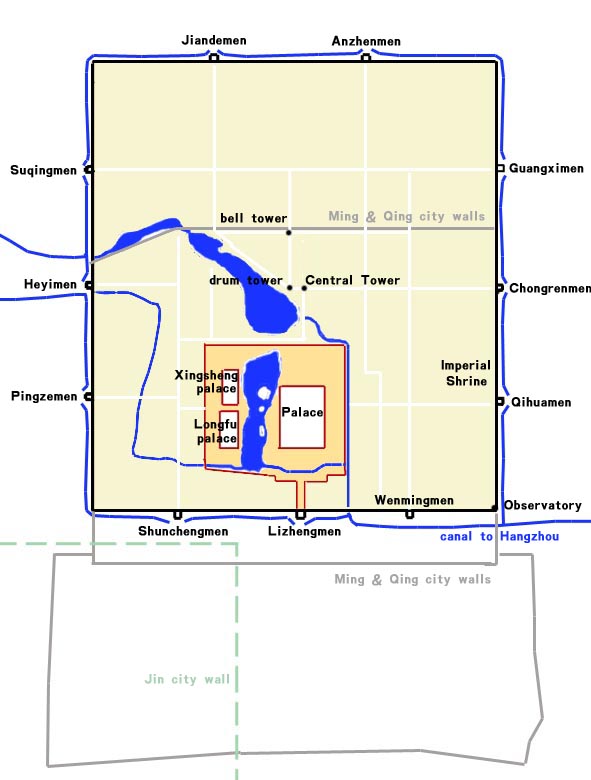Beijing has been the capital of China for some eight Centuries, and in a number of years as the Imperial Capital, it is exceeded only by Xi’an. (Chang et al.) The site has been continuously inhabited for thousands of years; the first large-scale settlement was some 3,000 years ago by Neolithic communities. During the Warring States period of the Zhou Dynasty, one of the feudal states, The Kingdom of Yan, made its capital Beijing and named it Ji. The Qin Dynasty destroyed the Yan Capital during the unification of China. It was only until the succeeding Han Dynasty was the city rebuilt, but Yan was just a mere provincial town for the next few centuries. (Chang et al.) However, Yan was on the border of Chinese Civilization, thus forming a vital position in defense of Northern China. The City grew under the later Han, Wei, and Sima Jin dynasties until it fell to nomadic tribes to the north of China during the turbulent Sixteen Kingdoms Era. For the next three centuries, from the end of the Sima Jin Dynasty to the esablishment of the Sui Dynasty, modern-day Beijing was under the control of various invading sinicized nomads such as the Former Yan and the Northern Wei. (Chang et al.) .[1]
Under the Sui and its inheritor the Tang Dynasty, the city was named Youzhou, a regional center of power and trade. Only after the fall of the Tang Dynasty did the city grow in importance; the invading Khitan established the Liao dynasty and made Youzhou one of their capitals, naming it Nanjing (Southern Capital). For the first time, Beijing was now as capital of a significant Chinese dynasty. The Khitan Liao dynasty would eventually fall to the Jurchen Jin Dynasty who made Nanjing (Beijing) their capital and renamed it Zhongdu. (Chang et al.).[2]
In 1217, Zhongdu was razed to the ground by Genghis Khan during his wars with the Jurchen Jin Dynasty. While the destruction wrought by the Mongols was terrible, it did unify the Eurasian Steppe opening a new route along the silk road. (Hansen, 391). Hansen refers to this route as the Grasslands route; many travelers from the East and the West traveled like Marco Polo and Qiu Chuji. The Terminus of this route was Mongol-era Beijing called Khanbaliq (also called Daidu or Dadu). Khanbaliq was constructed under the order of Kublai Khan in 1267 after the breakup of the united Mongol Empire. (Hansen, 405) According to Marco Polo, Khanbaliq was orderly and highly prosperous. The city was laid out in a square, with dirt walls surrounding, and the city laid out each block in squares that the Chinese called hutong. (Hansen, 407-408) The city was twenty-four miles around, forming a perfect square with four walls of exactly six miles each. The walls were white and ten paces across at the base and taper twenty paces high with three gates per wall. The city itself was laid out in straight lines with street lines lined with shops, palaces, and inns. Beyond the walls were extensive suburbs which housed a larger population than the city itself, prostitutes and lodging houses were located. (Philips, 204) The city impressed its visitors, especially Europeans, who often compared it to their native cities favorably. (Philips,206).
The wealth and status of Khanbaliq were further increased with the construction of the Tonghui Canal, which linked the great city with the Grand Canal and allowed for trade by boat. (Chang et al.) The city would survive the fall of the Yuan Dynasty (Kublai Khan and his descendants’ name for the Mongol regime.) and be renamed Beiping (Northern Peace) under the Ming. After the Yuan dynasty, the Grasslands route of the Silk Road Closed, and Beijing relied less on the Silk Road trade. (Hansen, 417) The Ming dynasty under the Yongle Emperor would later move the capital back to Beiping and finally, named the city Beijing which remains the name for the City as well as the capital of China. (Chang et al.).

The image Above is a layout of Yuan-Era Khanbaliq (Beijing) and others cities built on location.

The Beijing Bell Tower marked the geographic center of Dadu/Khanbaliq[3]
[1] This is the text of footnote one.
[2] This is the text of footnote two.
[3] This is the text of footnote three.
Hansen, Valerie. The Silk Road: A New History with Documents (Oxford, 2016).
Kim M. Philips, “Europe Looks East: Chinese Cities in Medieval Travel Writing, c.1298-c.1440,” Medieval Urban Culture 1 (2017), pp. 201-213.
Chang, Sen-dou and Bonavia, David Michael. "Beijing". Encyclopedia Britannica, 31 May. 2021, https://www.britannica.com/place/Beijing. Accessed 12 November 2021.